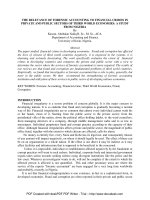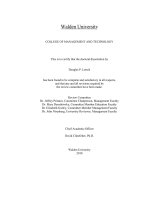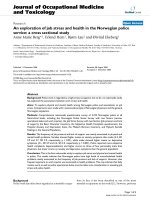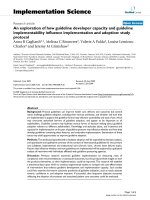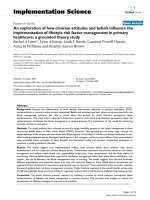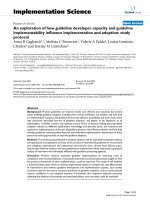An Exploration Of Forensic Accounting Education And Practice For Fraud Prevention And Detection In Nigeria
Bạn đang xem bản rút gọn của tài liệu. Xem và tải ngay bản đầy đủ của tài liệu tại đây (12.1 MB, 472 trang )
AN EXPLORATION OF
FORENSIC ACCOUNTING
EDUCATION AND PRACTICE
FOR FRAUD PREVENTION AND
DETECTION IN NIGERIA
EFIONG, EME JOEL
DOCTOR OF PHILOSOPHY
AUGUST, 2013
i
AN EXPLORATION OF FORENSIC ACCOUNTING
EDUCATION AND PRACTICE FOR FRAUD
PREVENTION AND DETECTION IN NIGERIA
BY
EFIONG, EME JOEL
A THESIS SUBMITTED TO THE FACULTY OF BUSINESS AND
LAW, DE MONTFORT UNIVERSITY, LEICESTER
IN PARTIAL FULFILMENT OF THE REQUIREMENTS FOR
THE AWARD OF THE DEGREE OF DOCTOR OF PHILOSOPHY
AUGUST, 2013
ii
ABSTRACT
Whereas the problem of fraud is a global one, the rate and extent to which it is
perpetrated in Nigeria, particularly in the public sector, is quite high and alarming.
Literature reveals that different fraud prevention and detection mechanisms are being
adopted to combat the menace of fraud; forensic accounting techniques appears to be
the most effective and are currently used in most developed countries of the world.
However, the extent to which forensic accounting techniques are being applied in
fraud prevention and detection in Nigeria is not known. Also, the intention to use
forensic accounting services in the public service has not been investigated.
This study was therefore aimed at examining the application of forensic accounting
techniques in fraud prevention and detection in Nigeria. Specific objectives were: (1)
to investigate the mechanisms of fraud prevention and detection, and their levels
of
effectiveness in Nigeria, (2) to identify the major factors that hinder the application
of forensic accounting techniques in fraud prevention and detection in Nigeria, (3) to
examine practitioners’ opinions and behavioural intention to use forensic accounting
techniques in fraud prevention and investigation in Nigeria, (4) to explore the level of
awareness of forensic accounting techniques in Nigeria and (5) to examine the
readiness of universities in taking up forensic accounting courses.
The study involved the collection of quantitative data. These data were collected from
three sets of populations, viz. accounting students, accounting academics and
accounting practitioners. The questionnaire served as the survey instruments. The data
collected were analysed using appropriate statistical techniques and computer
software.
iii
The study identified several fraud prevention and detection mechanisms that are
currently used in Nigeria, such as systems of internal controls, operational audits and
corporate code of conduct. Students’ t-test indicates a significant difference between
the perceived effectiveness and actual usage of fraud prevention and detection
mechanisms in Nigeria. It was further discovered that the most effective mechanisms,
like the forensic accounting techniques, are the least used in fraud prevention and
detection. This implies that the current mechanisms of fraud prevention and detection
are not proactive in dealing with the fraud menace.
Also, legal, educational and political factors were identified to hinder the application
of forensic accounting techniques in Nigeria. The level of awareness in forensic
accounting in Nigeria is generally low. While the one-way analysis of variance
indicates a significant variation among the three populations, it was discovered that
students had the lowest level of awareness. Further findings of the study reveal that
the universities are not yet ready to take up forensic accounting courses. Using the
structural equation modelling (SEM), all the other seven propositions were supported.
The findings of this study have both theoretical and practical implications.
Theoretically, it further strengthened the findings of previous studies on the
organisational intention. From the practical point of view, there is urgent need for
manpower development in universities with specialisation in forensic accounting.
Again, the educational institutions, and particularly the universities in Nigeria, would
need to include forensic accounting courses in the undergraduate curriculum as
education has been shown to be pivotal in creating awareness on the use of forensic
accounting techniques. Furthermore, from the sampled space, the study has captured
the current state of forensic accounting in Nigeria and the findings will be very useful
for the public service, private organisations and policy makers.
iv
DEDICATION
To the giver of knowledge, an unparallel God
and
Rev. Dr. Joel Efiong my unpaid friend.
v
ACKNOWLEDGEMENTS
My mouth shall always declare the goodness of my Lord for He has given strength to
the faint and wisdom; to him who has no might He increases knowledge. I didn’t
know you will honour me this way oh Lord my God. Thanks and thanks again.
I am deeply indebted to my supervisors (Prof. David Crowther and Dr. Ismail
Adelopo) for their professional guidance throughout the study period. I sincerely
thank Prof. David Crowther for opening his arms and giving me lots of comfort and
the push which was needed to get this study sorted. You encouraged me to actively
participate in several academic conferences which have contributed to the knowledge
I have shared in this study. I thank Dr. Ismail Adelopo, for all the support and
encouragement received during this process.
I acknowledge the invaluable contributions and assistance of Dr. Kamil Omoteso right
from when I was developing the proposal for the admission that culminated into this
study. I see you as my destiny helper, thanks very much. Prof. Descombe, Dr. Kumba
Jallow, Dr. Demola Obembe and Dr Olukemi Yekini are also appreciated for the
training we had to make the journey less burdensome.
My gratitude goes to the former Vice-Chancellor of the University of Calabar, Prof.
Bassey O. Asuquo, who encouraged me to seek admission for PhD programme
overseas and approved the sponsorship of same. I equally thank the entire
management of the University of Calabar as led by Prof James Epoke (VC) for the
continuous provision and providing the platform for me to access the Staff
Development Training Fund of the Educational Trust Fund (ETF), now Tertiary
Education Trust Fund (TETFund) for this study.
vi
I appreciate my PhD colleagues for making me feel at home: Albert Okorocha
Sarbarikor Lebura, Kanoporn Chaiprasit, Mfon Jeremiah, Deviraj Gill, Rochelle
Haynes, Suttimon Srichot, James Abiola, Ed Thompson and others.
This study used a large sample size to answer the research questions. This means that
without the corporation and responses of participants to the questionnaire the research
would have been inconclusive. In this regard, I particularly thank the following
persons: Eld. O. E. Ogban, Eld. Edet Efiong, Mr Sebastian Achom, Dr Mrs. Dorcas
Ayeni, Mr. and Mrs. Nathaniel Ebe, and Mr and Mrs Martins Akpapan in Lagos Dr.
Samuel Martins, Mrs. Adeyinka Esu, Prof. Emmanuel Daniel. I also appreciate all my
contact persons and 45 field assistants as the space would not be enough to write all
your names here.
I am total indebted to my family, my husband, Rev. Dr. Joel Efiong, for your
encouragements and taking care of our four children in my absence: and children;
Glorious-Praise, Cherish-Bethel, Emmanuel and Abundance Bethesda-Eti who was
born during the course of this study, for your patience, understanding and love. I
equally appreciate my father in-law Mr Efiong O. Ekpeyoung, my mother, Eld. Mrs.
Arit Ekpo, my uncle Arch Bassey E. Ekpo and siblings; Iniobong, Mandu, Ndanty
and Abasifreke, for their support and encouragements. I cannot forget the
encouragements of my dad, late Eld. Prof. T. N. Ekpo and mother in-law, late Mrs. I.
B. Ekanem, who both bowed out of this world during the final hours of this study.
You both had good wishes for me. Thank you and goodnight!
Lastly, I appreciate the Presbyterian Church of Nigeria, Esin Efut Efut Parish,
Calabar, Pastor and Pastor Mrs Victor Joel and family, Odu and Shane, Bro Sunny
Iliya, Sister Elizabeth and all the members of Redeemed Christian Church Green
vii
pastures and Hephzibah fellowship for their prayers for me while conducting this
research. I thank every other person who has contributed in one way or the other to
the success of this study, but whose name has not been mentioned here. Thank you
and God bless.
viii
TABLE OF CONTENTS
PAGE
Cover page
i
Title page
ii
Abstract
iii
Dedication
v
Acknowledgements
vi
Table of contents
ix
List of Tables
xix
List of Figures
xxiv
List of Appendices
xxix
CHAPTER ONE: INTRODUCTION
1
1.1
General introduction
2
1.2
Statement of the Research Problem
5
1.3
Aim and objectives of the study
11
1.3.1
Aim of the study
11
1.3.2
Objectives of the study
11
1.4
Research Questions
12
1.5
Propositions
13
1.6
Scope of the study
14
ix
1.7
Relevance of the study
15
1.8
Brief background on Nigeria
16
1.8.1
Origin, location, people and politics
16
1.8.2
Economy
17
1.8.3
Prevalence of fraud in the Nigerian environment
18
1.9
Brief methodology
21
1.10
Anticipated outcome
21
1.11
Organisation of the study
22
1.12
Conclusion
25
CHAPTER TWO:
BACKGROUND ON FRAUD AND FORENSIC
ACCOUNTING
26
2.1
Introduction
27
2.2
The concept of fraud
27
2.2.1
What is fraud?
27
2.2.2
Types of fraud
29
2.2.3
Causes of fraud
31
2.2.4
Effects of fraud
34
2.3
Forensic accounting
36
x
2.3.1
Meaning and concept of forensic accounting
36
2.3.2
Origin and growth of forensic accounting
39
2.3.3
Focus of forensic accounting
42
2.3.4
Basic skills of forensic accountant
43
2.3.5
Forensic accounting versus traditional accounting
46
2.3.6
Importance of forensic accounting
50
2.4
Mechanisms of fraud prevention and detection
54
2.4.1
Traditional accounting mechanism
54
2.4.2
Forensic accounting mechanisms
56
2.5
Corporate governance and fraud prevention
62
2.6
Conclusion
67
CHAPTER THREE:
REVIEW OF LITERATURE
3.1
Introduction
3.2
Use and effectiveness of fraud prevention and
68
69
detection mechanisms
69
3.3
Forensic accounting and, fraud prevention and detection
80
3.4
Forensic accounting education
89
3.4.1
The demand for forensic accounting education
89
xi
3.4.2
Evolution of forensic accounting education
92
3.5
Summary of literature review
96
3.6
Conclusion
97
CHAPTER FOUR: THEORETICAL UNDERPINNINGS AND
DEVELOPMENT OF PROPOSITIONS
98
4.1
Introduction
99
4.2
Theory and its importance in research
99
4.3
Theoretical underpinnings
101
4.3.1
Theory of demand and supply
102
4.3.2
The Health Belief Model
104
4.3.3
Theory of reasoned action
107
4.3.4
Hierarchy of effects models
110
4.3.5
The research model
113
Development of propositions
115
4.4
4.4.1
Variation in the perceived effectiveness and actual use of fraud
prevention and detection mechanisms
4.4.2
115
Practitioners’ intention to use forensic accounting techniques in
fraud prevention and detection
116
xii
4.4.2.1
Influence of external factors on awareness
4.4.2 .2
Influence of cognitive factors on behavioural intention to use
forensic accounting for fraud prevention and detection
4.4.2.3
4.4.4
4.5
118
Influence of threat perception factors on behavioural intention
to use forensic accounting for fraud prevention and detection
4.4.3
117
120
Variation in level of awareness among accounting practitioners,
students and academics
121
Readiness of universities to take up forensic accounting education
122
Conclusion
CHAPTER FIVE:
122
RESEARCH METHODOLOGY
124
5.1
Introduction
125
5.2
The research methodology framework
125
5.3
Research philosophy
129
5.3.1
Positivism
131
5.3.2
Realism
133
5.3.3
Interpretivism
134
5.3.4
Finding a common ground – pragmatism
137
5.3.5
Axiology
141
xiii
5.4
The research objectives, questions and proposition and methods- a linkage 141
5.5
Research approaches: quantitative vs. qualitative
145
5.6
Research strategy
145
5.6.1
5.7
Choice of research strategy
Conclusion
CHAPTER SIX:
146
146
PROCEDURE FOR DATA COLLECTION
AND ANALYSIS
147
6.1
Introduction
148
6.2
Procedure for data collection
148
6.2 .1
The population and samples
148
6.2.2
Selecting the samples
151
6.2.3
Nature and sources of data
160
6.2.4
Access negotiation
161
6.2.5
Sampling
163
6.2.5.1
Sampling of practitioners
163
6.2.5.2
Sampling of students
165
6.2.5.3
Sampling of academics
166
xiv
6.2.7
Research instruments
167
6.2.8
The research variables
171
6.2 .9
Scale of measurement
172
6.2.10
Pilot study
175
6.2.11
Questionnaire administration and retrieval
176
6.3
Data preparation and analysis procedure
179
6.3.1
Data preparation
179
6.3.2
Procedure for data analysis
180
6.3.2.1
Descriptive statistical analysis
180
6.3.2.2
Inferential statistical analysis
180
6.4
Creditability of research methods and findings – reliability, validity
and generalisability
190
6.5
Ethical issues
197
6.10
Research time horizons
199
6.11
Conclusion
200
xv
CHAPTER SEVEN: RESULTS, ANALYSIS DATA AND TEST OF
PROPOSITIONS
201
7.1
Introduction
202
7.2
Results and analysis of responses from accounting practitioners
204
7.2.1
Demographic information of practitioners
204
7.2.2
Data on fraud prevention and detection mechanisms
210
7.2.3
Test of proposition 1
213
7.2.4
Factor analysis
213
7.2.5
Data and analysis of accounting practitioners’ awareness of
7.2.6
forensic accounting
221
Structural equation modelling
222
7.2.6.1
Evaluation of measurement model
222
7.2.6.2
Evaluation of the structural model
239
7.2.6.3
Test of model propositions (Propositions 2 – 8)
251
7.3
Results and analysis of responses from students
254
7.3.1
Data entry and cleaning
255
7.3.2
Demographic details of student respondents
256
7.3.3
Opinion and behaviour of undergraduate students towards
forensic accounting education
260
xvi
7.4
Results and analysis of response from accounting academics
270
7.4.1
Data entry observation and cleaning
270
7.4.2
Demographic details of academics
271
7.4.3
Opinion of respondents on nature of fraud and forensic accounting
in Nigeria
7.5
Variation in the levels of awareness among accounting practitioners,
students and academics and test of proposition 9
7.6
279
289
Readiness of Nigerian universities to take up forensic accounting
courses and test of proposition 10
293
7.7
Summary of the chapter
293
7.8
Conclusion
295
CHAPTER EIGHT: DISCUSSION OF FINDINGS
296
8.1
Introduction
297
8.2
Mechanisms of fraud prevention and detection, and their perceived
levels of effectiveness
297
8.3
Factors that hinder the application of forensic accounting techniques
299
8.4
Practitioners’ intention to use forensic accounting techniques in fraud
8.5
prevention and detection
302
Forensic accounting education
306
xvii
8.5.1
Level of awareness of forensic accounting techniques
among practitioners, students and academics
8.5.2
Readiness of Nigerian universities to offer forensic
accounting courses
8.6
306
Conclusion
308
309
CHAPTER NINE: SUMMARY AND CONCLUSION
310
9.1
Introduction
311
9.2
Summary of chapters
314
9.3
Summary of findings
316
9.4
Contribution to knowledge
319
9.5
Limitations and generalisability of the research findings
320
9.6
Policy recommendations
322
9.7
Lessons learnt from the study
324
9.8
Suggestions for further studies
324
9.9
Conclusion
325
References
Appendices
xviii
LIST OF TABLES
PAGE
Table 4.1:
Key constructs and definitions of the health belief model
105
Table 5.1:
Philosophical assumptions of positivism
133
Table 5.2:
Contrasting implications of the positivism and the
interpretivism/social constructivism
Table 5.3
136
Methodological implications of different epistemologies
in social research
137
Table 5.4:
Matching of research questions and propositions with objectives
143
Table 6.1:
Availability of accounting degree programmes at federal
universities in the sampled zone
159
Table 6.2:
Number of ministries and agencies in the selected states
164
Table 6.3:
Minimum sample size
166
Table 6.4:
Distribution of accounting academics across the
sampled universities
167
Table 6.5:
Dependent and independent variables
173
Table 6.6:
Perspectives of reliability
191
Table 6.7:
Perspectives of validity
195
Table 7.1:
Demographic data of practitioners
205
Table 7.2:
Ranking of perceived effectiveness of fraud prevention
and detection mechanisms
Table 7.3:
Ranking of the actual use of fraud prevention and detection
mechanisms
Table 7.4:
211
212
Difference in use and effectiveness of fraud prevention
and detection mechanisms
213
xix
Table 7.5:
Correlation matrix of factors that hinder the application
of forensic accounting
214
Table 7.6:
KMO and Bartlett’s test
215
Table 7.7:
Communalities
216
Table 7.8:
Total variance explained
217
Table 7.9:
Rotated component matrix
219
Table 7.10:
Accounting practitioners’ awareness of forensic accounting
221
Table 7.11:
Accounting practitioners’ level of awareness of forensic
accounting
221
Table 7.12:
Reliability and convergent validity test
223
Table 7.13:
Correlation matrix for the assessment of discriminant validity
224
Table 7.14:
Parameter summary
228
Table 7.15:
Degrees of freedom and chi-square
228
Table 7.16:
Goodness-of-fit-index
229
Table 7.17:
Root Mean Square Error of Approximation (RMSEA)
230
Table 7.18:
Baseline comparisons
231
Table 7.19:
Unstandardised regression weights
231
Table 7.20:
Standardised regression weights
232
Table 7.21:
Modification indices
233
Table 7.22:
Chi-square of the modified model
236
Table 7.23:
Unstandardised regression weights of modified model
237
Table 7.24:
Standardised regression weights of modified model
238
Table 7.25:
Unstandardised regression weights of structural model
242
xx
Table 7.26:
Standardised regression weights of structural model
Table 7.27:
Squared multiple correlations of the structural model from
AMOS output
Table 7.28:
244
246
Summary of coefficient of determination R for endogenous
constructs
247
Table 7.29:
Modification indices for the structural model
248
Table 7.30:
Test of propositions from SEM
251
Table 7.31:
Validating of data entry
255
Table 7.32:
Student respondents’ university
256
Table 7.33:
Student respondents’ gender
257
Table 7.34:
Student respondents’ age
258
Table 7.35:
Student respondents’ year of study
259
Table 7.36:
Awareness of the existence of forensic accounting
260
Table 7.37:
First source of information on forensic accounting
261
Table 7.38:
Level of awareness of forensic accounting by undergraduates
263
Table 7.39:
University offers fraud prevention and detection courses
264
Table 7.40:
Availability of forensic accounting academics (lecturers)
265
Table 7.41:
Knowledge of forensic accounting will make positive impact
on undergraduates’ training
Table 7.42:
Knowledge of forensic accounting by accountants and auditors
will make positive impact in the fight against fraud
Table 7.43:
266
267
Frequency table for chi-square test of the perceived effect of
knowledge of forensic accounting on student
268
xxi
Table 7.44:
Frequency table for chi-square test of the perceived effect of
knowledge of forensic accounting on accountants and auditors
268
Table 7.45:
Chi-square test statistics
269
Table 7.46:
Accuracy of data entry for responses from academics
270
Table 7.47:
University of academics
271
Table 7.48:
Gender of academics
272
Table 7.49:
Age distribution of academics
273
Table 7.50:
Highest educational qualification of academics
274
Table 7.51:
Present rank of academics
275
Table 7.52:
Years of teaching
276
Table 7.53:
Area of specialisation of academics
277
Table 7.54:
Awareness of existence of forensic accounting
278
Table 7.55:
Level of awareness of forensic accounting by academics
279
Table 7.56:
High rate of fraud in Nigeria
279
Table 7.57:
Forensic accounting can help in fraud prevention
280
Table 7.58:
Teaching forensic accounting and enhancement fraud prevention
and detection
281
Table 7.59 :
Forensic accounting in teaching curriculum
282
Table 7.60:
Lecturers and teaching forensic accounting in
Nigerian universities
283
Table 7.61:
I will like FA to be taught in my university
284
Table 7.62:
Universities are ready to take up courses in forensic accounting
285
Table 7.63:
Chi-square test of opinions of academics
287
Table 7.64:
Levels of awareness of forensic accounting among
practitioners, students and academics
288
xxii
Table 7.65:
One-way analysis of variation in the level of awareness
among practitioners, students and academics
289
Table 7.66:
Descriptive statistics of the one-way analysis of variance
289
Table 7.67:
Results of Scheffe’s post hoc tests of multiple comparisons 291
xxiii
LIST OF FIGURES
Figure 1.1:
PAGE
Map of Nigeria, showing the thirty-six Federating
units and the Federal Capital Territory, Abuja
17
Figure 1.2:
Organisation of the study
24
Figure 2.1:
The fraud triangle
32
Figure 2.2 :
The three-fold approach of forensic accounting
46
Figure 2.3:
Corporate governance and its functions
65
Figure 4.1:
Hierarchical relationships between theory, concepts,
constructs and variables
101
Figure 4.2:
Components of the Health Belief Model
106
Figure 4.3:
Model of the Theory of Reason Action
109
Figure 4.4:
Hierarchy of Effects Model
111
Figure 4.5:
The research model
115
Figure 5.1:
The research onion
126
Figure 6.1:
Population, sample and individual cases
149
Figure 6.2:
The different sampling techniques
152
Figure 6.3:
Map of Nigeria showing the six geo-political zones
156
Figure 6.4:
Federal universities in clusters of geo-political zones
157
Figure 6.5:
Types of questionnaire
168
Figure 6.6:
Key principles in research ethics
198
xxiv
Figure 7.1:
Percentage distribution of gender among practitioners
204
Figure 7.2:
Percentage distribution of age among practitioners
206
Figure 7.3:
Percentage distribution of educational qualification among
practitioners
Figure 7.4:
Percentage distribution of professional qualifications among
practitioners
Figure 7.5:
207
208
Percentage distribution of years of experience among
practitioners
209
Figure 7.6:
Percentage distribution of job descriptions among practitioners
209
Figure 7.7:
Scree plot
218
Figure 7.8:
Input measurement model
225
Figure 7.9:
Output measurement model
227
Figure 7.10:
Modified input model of confirmatory factor analysis
234
Figure 7.11:
Modified output model of confirmatory factor analysis
235
Figure 7.12:
Input structural model
240
Figure 7.13:
Output structural model
241
Figure 7.14:
Modified input structural model
249
Figure 7.15:
Modified output structural model
250
Figure 7.16:
Percentage distribution of student respondents across
xxv


